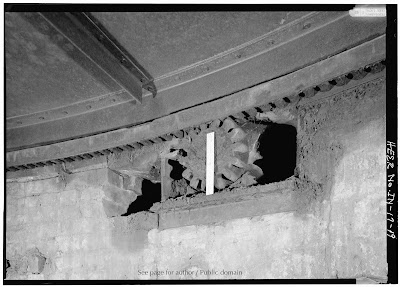Montgomery County Jail Building
In 1881, architect William H. Brown answered the human incarceration problem with an engineering solution by designed a revolutionary new jail concept in housing criminals. Brown teamed up with Benjamin F. Haugh. Haugh, Ketcham & Co. iron foundry in Indianapolis, Indiana build this modern masterpiece.
What was this work of genius, you may ask? A rotary jail.
Hmm… Sounds a bit odd. But whenever someone comes up with a new solution or new take on an old problem, it can seem odd. Let’s find out how this one stacks up on the oddity chart.
Brown’s idea was to have a revolving cell block. There were generally eight wedge-shaped cells per floor with a single exit shared by all the cells on that floor. This way only one cell could be accessed at a time, providing more security and fewer guards required to oversee the prisoners.
The patent for this new style of jail had this description:
“The object of our inventions is to produce a jail in which prisoners can be controlled without the necessity of personal contact between them and the jailer or guard ... it consists, first, of a circular cell structure of considerable size (inside the usual prison building) divided into several cells capable of being rotated, surrounded by a grating in close proximity thereto, which has only such number of openings (usually one) as is necessary for the convenient handling of prisoners.”
Cell Door Partially Open & Cell Door Open
The greased mechanism was so well-built and the unit sat on a ball-bering surface that a single man could work the crank to spin the entire block.
This video shows a man cranking the handle to rotate the cell block.
https://www.youtube.com/watch?v=MIswvJFoT0A
Rotating Crank Mechanism
In the late 1800s, several of these rotary jails were built across the American Midwest. The first was constructed in Crawfordsville, Indiana in 1882. Five others were soon built in the Midwest. In total, eighteen of these bad boys were erected at a cost of $30,000 each.
The rotary jail boasted an indoor, sanitary plumbing system, a luxury most regular people didn’t have yet. Prisoners received three meals a day, a hot bath, and their clothes laundered. A pretty sweet deal.
Very quickly the pitfalls and safety hazards to this style of construction became evident. First, the jails often held mostly individuals too inebriated to walk. They might pass out in their cell with an arm or leg through the bars. Then when the cell block was rotated, arms and legs were injured ... or worse.
Another hazard was what to do in case of a fire. A guard would need to stay behind to turn the crank handle to let the prisoners out one wedge-shaped cell at a time. Who was going to watch these freed prisoners with the reduced manpower? And what if the guard was too afraid for his own life to stay inside a burning building. Not good. A set up for failure.
Due to the safety hazards, most of the rotary jails had their mechanisms welded into a stationary position and doors made for each cell within a few years. Nearly all of these jails were decommissioned by 1939. The Pottawattamie County jail in Council Bluffs, Iowa was the last of these jails in service. It shut down in December of 1969. It’s rotating mechanism was still in use up to 1960.
Food Pass-Through Slot
The Montgomery County rotary jail in Crawfordsville, Indiana is the only one of these jails still able to rotate. However, no prisoners are housed there as it is now a museum. This would be so much fun to visit.
I would give Brown high marks for ingenuity, creativity, and out of the box thinking. But very-low marks for safety considerations before construction and cost savings for their clients. I wonder if any of the towns, which had these jails built, recouped the money they were supposed to save with paying fewer guards.
NEW RELEASE!!!
THE DÉBUTANTE'S SECRET (Quilting Circle 4)
Will Geneviève open her heart to a love she never imagined?
Washington State 1894
Geneviève Marseille has one purpose in coming to Kamola—stopping her brother from digging up the past. Deputy Montana has lived a simple life. But when a fancy French lady steps off the train and into his arms, his modest existence might not be enough anymore. A nemesis from Aunt Henny's past arrives in town threatening her with jail. Will she flee as she’d done all those years ago, or stand her ground in the town she’s made her home? When secrets come out, will the lives of Geneviève, Montana, and Aunt Henny ever be the same?















No comments:
Post a Comment